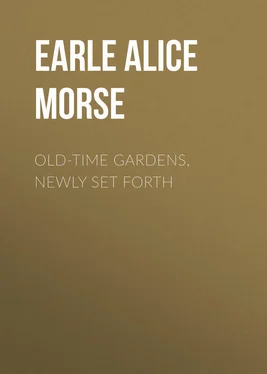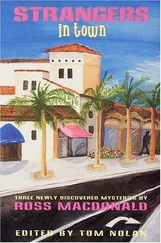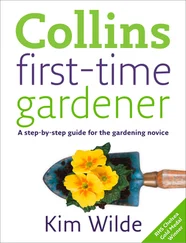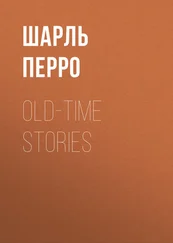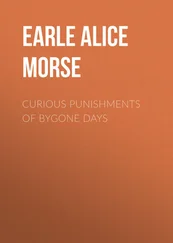Alice Earle - Old-Time Gardens, Newly Set Forth
Здесь есть возможность читать онлайн «Alice Earle - Old-Time Gardens, Newly Set Forth» — ознакомительный отрывок электронной книги совершенно бесплатно, а после прочтения отрывка купить полную версию. В некоторых случаях можно слушать аудио, скачать через торрент в формате fb2 и присутствует краткое содержание. Жанр: foreign_antique, foreign_prose, на английском языке. Описание произведения, (предисловие) а так же отзывы посетителей доступны на портале библиотеки ЛибКат.
- Название:Old-Time Gardens, Newly Set Forth
- Автор:
- Жанр:
- Год:неизвестен
- ISBN:нет данных
- Рейтинг книги:3 / 5. Голосов: 1
-
Избранное:Добавить в избранное
- Отзывы:
-
Ваша оценка:
- 60
- 1
- 2
- 3
- 4
- 5
Old-Time Gardens, Newly Set Forth: краткое содержание, описание и аннотация
Предлагаем к чтению аннотацию, описание, краткое содержание или предисловие (зависит от того, что написал сам автор книги «Old-Time Gardens, Newly Set Forth»). Если вы не нашли необходимую информацию о книге — напишите в комментариях, мы постараемся отыскать её.
Old-Time Gardens, Newly Set Forth — читать онлайн ознакомительный отрывок
Ниже представлен текст книги, разбитый по страницам. Система сохранения места последней прочитанной страницы, позволяет с удобством читать онлайн бесплатно книгу «Old-Time Gardens, Newly Set Forth», без необходимости каждый раз заново искать на чём Вы остановились. Поставьте закладку, и сможете в любой момент перейти на страницу, на которой закончили чтение.
Интервал:
Закладка:
"We have a bright little garden, down on a sunny slope,
Bordered with sea-pinks and sweet with the songs and blossoms of hope."
The garden of Secretary William H. Seward (in Auburn, New York), so beloved by him in his lifetime, is shown on page 146 and facing page 134. In this garden some beds are edged with Periwinkle, others with Polyanthus, and some with Ivy which Mr. Seward brought from Abbotsford in 1836. This garden was laid out in its present form in 1816, and the sun-dial was then set in its place. The garden has been enlarged, but not changed, the old "George II. Roses" and York and Lancaster Roses still grow and blossom, and the lovely arches of single Michigan Roses still flourish. In it are many flowers and fruits unusual in America, among them a bed of Alpine strawberries.
King James I. of Scotland thus wrote of the garden which he saw from his prison window in Windsor Castle: —
"A Garden fair, and in the Corners set
An Herbere greene, with Wandis long and small
Railit about."
These wandis were railings which were much used before Box edgings became universal. Sometimes they were painted the family colors, as at Hampton Court they were green and white, the Tudor colors. These "wandis" still are occasionally seen. In the Berkshire Hills I drove past an old garden thus trimly enclosed in little beds. The rails were painted a dull light brown, almost the color of some tree trunks; and Larkspur, Foxglove, and other tall flowers crowded up to them and hung their heads over the top rails as children hang over a fence or a gate. I thought it a neat, trim fashion, not one I would care for in my own garden, yet not to be despised in the garden of another.
A garden enclosed! so full of suggestion are these simple words to me, so constant is my thought that an ideal flower garden must be an enclosed garden, that I look with regret upon all beautiful flower beds that are not enclosed, not shut in a frame of green hedges, or high walls, or vine-covered fences and dividing trees. It may be selfish to hide so much beauty from general view; but until our dwelling-houses are made with uncurtained glass walls, that all the world may see everything, let those who have ample grounds enclose at least a portion for the sight of friends only.
In the heart of Worcester there is a fine old mansion with ample lawns, great trees, and flowering shrubs that all may see over the garden fence as they pass by. Flowers bloom lavishly at one side of the house; and the thoughtless stroller never knows that behind the house, stretching down between the rear gardens and walls of neighboring homes, is a long enclosure of loveliness – sequestered, quiet, full of refreshment to the spirits. We think of the "Old Garden" of Margaret Deland: —
"The Garden glows
And 'gainst its walls the city's heart still beats.
And out from it each summer wind that blows
Carries some sweetness to the tired streets!"
There is a shaded walk in this garden which is a thing of solace and content to all who tread its pathway; a bit is shown opposite this page, overhung with shrubs of Lilac, Syringa, Strawberry Bush, Flowering Currant, all the old treelike things, so fair-flowered and sweet-scented in spring, so heavy-leaved and cool-shadowing in midsummer: what pleasure would there be in this shaded walk if this garden were separated from the street only by stone curbing or a low rail? And there is an old sun-dial too in this enclosed garden! I fear the street imps of a crowded city would quickly destroy the old monitor were it in an open garden; and they would make sad havoc, too, of the Roses and Larkspurs (page 65) so tenderly reared by the two sisters who together loved and cared for this "garden enclosed." Great trees are at the edges of this garden, and the line of tall shrubs is carried out by the lavish vines and Roses on fences and walls. Within all this border of greenery glow the clustered gems of rare and beautiful flowers, till the whole garden seems like some rich jewel set purposely to be worn in honor over the city's heart – a clustered jewel, not one to be displayed carelessly and heedlessly.
Salem houses and gardens are like Salem people. Salem houses present to you a serene and dignified front, gracious yet reserved, not thrusting forward their choicest treasures to the eyes of passing strangers; but behind the walls of the houses, enclosed from public view, lie cherished gardens, full of the beauty of life. Such, in their kind, are Salem folk.
I know no more speaking, though silent, criticism than those old Salem gardens afford upon the modern fashion in American towns of pulling down walls and fences, removing the boundaries of lawns, and living in full view of every passer-by, in a public grassy park. It is pleasant, I suppose, for the passer-by; but homes are not made for passers-by. Old Salem gardens lie behind the house, out of sight – you have to hunt for them. They are terraced down if they stretch to the water-side; they are enclosed with hedges, and set behind high vine-covered fences, and low out-buildings; and planted around with great trees: thus they give to each family that secluded centring of family life which is the very essence and being of a home. I sat through a June afternoon in a Salem garden whose gate is within a stone's throw of a great theatre, but a few hundred feet from lines of electric cars and a busy street of trade, scarce farther from lines of active steam cars, and with a great power house for a close neighbor. Yet we were as secluded, as embowered in vines and trees, with beehives and rabbit hutches and chicken coops for happy children at the garden's end, as truly in beautiful privacy, as if in the midst of a hundred acres. Could the sense of sound be as sheltered by the enclosing walls as the sense of sight, such a garden were a city paradise.
There is scant regularity in shape in Salem gardens; there is no search for exact dimensions. Little narrow strips of flower beds run down from the main garden in any direction or at any angle where the fortunate owner can buy a few feet of land. Salem gardens do not change with the whims of fancy, either in the shape or the planting. A few new flowers find place there, such as the Anemone Japonica and the Japanese shrubs; for they are akin in flower sentiment, and consort well with the old inhabitants. There are many choice flowers and fruits in these gardens. In the garden of the Manning homestead (opposite page 112) grows a flourishing Fig tree, and other rare fruits; for fifty years ago this garden was known as the Pomological Garden. It is fitting it should be the home of two Robert Mannings – both well-known names in the history of horticulture in Massachusetts.
The homely back yard of an old house will often possess a trim and blooming flower border cutting off the close approach of the vegetable beds (see opposite page 66). These back yards, with the covered Grape arbors, the old pumps, and bricked paths, are cheerful, wholesome places, generally of spotless cleanliness and weedless flower beds. I know one such back yard where the pump was the first one set in the town, and children were taken there from a distance to see the wondrous sight. Why are all the old appliances for raising water so pleasing? A well-sweep is of course picturesque, with its long swinging pole, and you seem to feel the refreshment and purity of the water when you see it brought up from such a distance; and an old roofed well with bucket, such as this one still in use at Bishop Berkeley's Rhode Island home is ever a homelike and companionable object. But a pump is really an awkward-looking piece of mechanism, and hasn't a vestige of beauty in its lines; yet it has something satisfying about it; it may be its domesticity, its homeliness, its simplicity. We have gained infinitely in comfort in our perfect water systems and lavish water of to-day, but we have lost the gratification of the senses which came from the sight and sound of freshly drawn or running water. Much of the delight in a fountain comes, not only from the beauty of its setting and the graceful shape of its jets, but simply from the sight of the water.
Читать дальшеИнтервал:
Закладка:
Похожие книги на «Old-Time Gardens, Newly Set Forth»
Представляем Вашему вниманию похожие книги на «Old-Time Gardens, Newly Set Forth» списком для выбора. Мы отобрали схожую по названию и смыслу литературу в надежде предоставить читателям больше вариантов отыскать новые, интересные, ещё непрочитанные произведения.
Обсуждение, отзывы о книге «Old-Time Gardens, Newly Set Forth» и просто собственные мнения читателей. Оставьте ваши комментарии, напишите, что Вы думаете о произведении, его смысле или главных героях. Укажите что конкретно понравилось, а что нет, и почему Вы так считаете.
